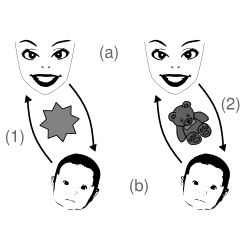
Nello sviluppo infantile umano, un oggetto transizionale è un qualcosa, qualcosa, solitamente un oggeto fisico, che prende il posto del legame madre-figlio. Gli esempi più comuni includono bambole, orsacchiotti o coperte.
Donald Woods Winnicott ha introdotti i concetti di oggetti transizionali e fenomeni transizionali (o esperienze transizionali) riferendosi a un particolare momento dello sviluppo. Per ‘transizionale’ Winnicott intende una fase di sviluppo intermedia fra quella psichica e della realtà esterna. In questa ‘area transizionale’ possiamo individuare gli ‘oggetti transizionali’.
When the young child begins to separate the ‘me’ from the ‘not-me’ and evolves from complete dependence to a stage of relative independence, it uses transitional objects. An infant sees himself and the mother as a whole. In this phase the mother ‘brings the world’ to the infant without delay which gives him a ‘moment of illusion’, a belief that his own wish creates the object of his desire which brings with it a sense of satisfaction. Winnicott calls this subjective omnipotence. Alongside the subjective omnipotence of a child lies an objective reality, which constitutes the child’s awareness of separateness between himself and desired objects. While the subjective omnipotence experience is one in which the child feels that his desires create satisfaction, the objective reality experience is one in which the child independently seeks out objects of desire.[senza fonte]
Later on the child comes to realize that the mother is separate from him through which it appears that the child has lost something. The child realizes that he is dependent on others and thus he loses the idea that he is independent, a realization which creates a difficult period and brings frustration and anxiety with it. In the end it is impossible that the mother is always there to ‘bring the world’ to the baby, a realization which has a powerful, somewhat painful, but constructive impact on the child. Through fantasizing about the object of his wishes the child will find comfort. A transitional object can be used in this process. The transitional object is often the first ‘not me’ possession that really belongs to the child. These could be real objects like a blanket or a teddy bear, but other ‘objects’, such as a melody or a word, can fulfill this role as well. This object represents all components of ‘mothering’, and it means that the child himself is able to create what he needs as well. It enables the child to have a fantasized bond with the mother when she gradually separates for increasingly longer periods of time. The transitional object is important at the time of going to sleep and as a defence against anxiety.[senza fonte]
In a later stage of the development the child no longer needs the transitional object. He is able to make a distinction between ‘me’ and ‘not-me’, and keeping inside and outside apart and yet interrelated. This development leads to the use of illusion, symbols and objects later on in life.
Winnicott related the concept of transitional object to a more general one, transitional phenomena, which he considered to be the basis of science, religion and all of culture. Transitional objects and phenomena, he said, are neither subjective nor objective but partake of both. In Mental Space (1994, ch. 8), Robert Young has provided an exposition of these concepts and has generalized their role into psychic phenomena in adult life (Young,1989).
See also
[modifica | modifica wikitesto]<nowiki> Categoria:Sessualità <nowiki>








